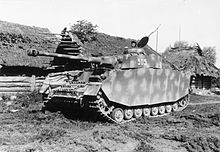12th Panzer Division (Wehrmacht)
| 12th Panzer Division | |
|---|---|
| 12. Panzerdivision — 12. PzDiv — | |
| Active | 10 January 1941 – 8 May 1945 |
| Country | |
| Branch | German Heer |
| Type | Panzer |
| Role | Armoured warfare |
| Size | Division |
| Part of | |
| Garrison/HQ | Wehrkreis II: Stettin |
| Engagements | World War II |
| Insignia | |
| Identification symbol | |
| summer 1943 | |
The 12th Panzer Division was an armoured division in the German Army, the Wehrmacht, during World War II, established in 1940.
In October 1940 the 2nd Motorised Infantry Division was reorganized as the 12th Panzer Division, and in June 1941 it joined Operation Barbarossa, fighting in the battles of Minsk and Smolensk. It fought the rest of the war on the Eastern Front and surrendered to the Red Army in the Courland Pocket in May 1945.
History[]

The division was formed from the 2nd Infantry Division, itself formed in 1921. The division was motorised in 1936–37 and participated in the invasions of Poland and France. It was reorganised as a Panzer Division in October 1940.[1]
The 12th Panzer Division participated in Operation Barbarossa, taking part in the drive towards Leningrad. Suffering heavy casualties during the Soviet counter offensive in the winter of 1941–42, the division was withdrawn to Estonia for a refit.[1] It remained with Army Group North for the most part of the war except for a brief spell south while participating in the battle of Kursk in July 1943 and the following defensive operations and retreat after the German failure. The division returned to the northern sector in January 1944 but came too late to play any role in the unsuccessful German efforts to prevent the Siege of Leningrad from being broken by the Red Army. It was eventually entrapped in the Courland Pocket after the successful Soviet offensive in July 1944, Operation Bagration. It remained in Courland where it surrendered to Soviet forces in May 1945.[2]
Organization[]
Structure of the division through its history:[3]
- Headquarters
- 29th Panzer Regiment
- 5th Panzergrenadier Regiment
- 25th Panzergrenadier Regiment
- 2nd Panzer Artillery Regiment
- 22nd Motorcycle Battalion (later became 2nd Panzer Reconnaissance Battalion)
- 508th Tank Destroyer Battalion
- 303rd Army Anti-Aircraft Battalion (later added in 1942)
- 2nd Divisional Supply Group
Commanding officers[]
The commanders of the division:[4]
- Lieutenant general Fedor von Bock, 1931
- Major General/Lieutenant General Hubert Gerke, 1 October 1934
- Major General/Lieutenant General Paul Bader, 1 April 1937
- Generaloberst Josef Harpe, 5 October 1940
- Generalleutnant Walter Wessel, 15 January 1942
- Generalleutnant Erpo Freiherr von Bodenhausen, 1 March 1943
- Generalmajor Gerhard Müller, 28 May 1944
- Generalleutnant Erpo Freiherr von Bodenhausen, 16 July 1944
- Oberst Horst von Usedom, 12 April 1945
See also[]
- Organisation of a SS Panzer Division
- Panzer division
References[]
- ^ Jump up to: a b Mitcham, p. 109
- ^ Mitcham, p. 110
- ^ German Order of Battle, Panzer, Panzer Grenadier, and Waffen SS Division in WWII. p. 19.
- ^ Mitcham, p. 110–111
Bibliography[]
Note: The Web references may require you to follow links to cover the unit's entire history.
- Mitcham, Samuel W. (2000). The Panzer Legions. Mechanicsburg: Stackpole Books. ISBN 978-0-8117-3353-3.
- Stoves, Rolf (1986). Die Gepanzerten und Motorisierten Deutschen Grossverbände 1935 – 1945 [The armoured and motorised German divisions and brigades 1935–45]. Bad Nauheim: Podzun-Pallas Verlag. ISBN 3-7909-0279-9.
- Guderian, Heinz (1957) [1952]. Panzer Leader (abridged) (First Ballantine Books ed.). New York: Ballantine Books. ISBN 0-345-25329-9.
- Burkhard Müller-Hillebrand: Das Heer 1933-1945. Entwicklung des organisatorischen Aufbaues. Vol.III: Der Zweifrontenkrieg. Das Heer vom Beginn des Feldzuges gegen die Sowjetunion bis zum Kriegsende. Mittler: Frankfurt am Main 1969, p. 285.
- Georg Tessin: Verbände und Truppen der deutschen Wehrmacht und Waffen-SS im Zweiten Weltkrieg, 1939 - 1945. Vol. II: Die Landstreitkräfte 1 - 5. Mittler: Frankfurt am Main 1966.
- Georg Tessin: Verbände und Truppen der deutschen Wehrmacht und Waffen-SS im Zweiten Weltkrieg, 1939 - 1945. Vol. III: Die Landstreitkräfte 6 - 14. Mittler: Frankfurt am Main 1967.
- German panzer divisions
- Military units and formations established in 1941
- 1934 establishments in Germany
- Military units and formations disestablished in 1945